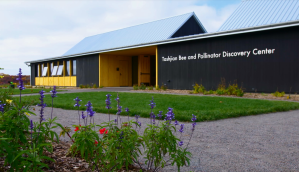John Tolley, November 3, 2017
Consider the bee. Do they sting? Yes, but it?s a mild annoyance at worst. Without them, though, you can say goodbye to a great number of things, chief among them the bountiful offerings of your local supermarket.
The myriad threats that bees face are grave, to be sure, but they have a powerful ally fighting for them: the University of Minnesota?s Bee Lab.
?Bees are suffering from many problems all at once,? explains Minnesota entomologist and MacArthur Fellow Dr. Marla Spivak. ?They have disease, they have parasites, they don?t have enough flowers to provide good nutrition and some of the flowers they do have are contaminated with pesticides. All of these things act on them at once to decrease their health. What we?re doing here in Minnesota is trying to establish good bee health.?
For 25 years, Spivak has conducted extensive research into native and nonnative at Minnesota and has overseen the creation, growth and operation of the university?s Bee Lab, one of the nation?s preeminent melittological research facilities.
The goal of lab is to restore the health of bee colonies in the most natural way possible, and their research is centered largely on how bees combat threats to their hive?s overall wellbeing. ?We study their self-defenses, how they sniff out and remove diseased brood from the nest, how they collect antimicrobial resins that are their medicine.?
Another main area of inquiry for Bee Lab researchers, such as university entomologist Bob Koch, is how to effectively reduce the amount of pesticides used in crop production without reducing agricultural output. While they readily acknowledge the need for pest reduction measures, Koch and his team are looking into how crops, particularly soybeans, can be defended without powerful chemicals that can harm pollinators.
?We have identified soybeans lines that have resistance to the soybean aphid and we?re working to try to increase the availability of these lines,? says Koch. ?We also know that there are different natural enemies, such as parasitic wasps, that are very effective for suppressing these aphids. Our work is trying to find ways to better incorporate those natural enemies into soybean production and decrease the adverse impacts of other production practices on beneficial insects.?

At their new Discovery Center facility, located at Minnesota?s Landscape Arboretum, the Bee Lab conducts outreach to educate the general public about bees - and other pollinators, such as the monarch butterfly - and their role in the ecosystem. They also provide information about how the public can help bolster the bee population through simply planting more flowers and reducing, or eliminating, pesticides used in gardens and flower beds.
According to Spivak, the location of the Bee Lab on the campus of one of the Midwest?s premier universities is hardly coincidental; it is a strategic location that helps them do the most good for a key agricultural asset. ?The upper-Midwest is where most of the honey is made in our nation. Many of our beekeepers move here during the summer months and this is the only facility in a four-state area where we?re doing bee research. So we?re providing a service for most of our nation?s bees here.?







